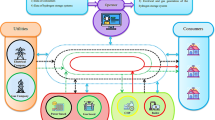Abstract
Because buildings have certain heat capacity, when the thermal power changes, the indoor temperature has a relative lag of change, while the feeling to comfortable temperature of the human body lies within a certain range. Based on the energy storage characteristics of buildings, this paper structures the optimal dispatch model of a combined cooling, heating, and power system (CCHP) and the virtual energy storage system (VESS) is integrated into the model of optimizing schedule on microgrid. This will achieve the charge and discharge management of microgrid virtual energy storage system, with the optimization objectives of minimizing the economic, environmental and energy indexes through determining the weight coefficient of each index by analytic hierarchy process (AHP) and through the adjustment of the indoor temperature of the building within the range of human comfort. Finally, taking the summer refrigeration scenario as an example and comparing two microgrids of two types of buildings with or without virtual energy storage, this paper concludes that compared with traditional optimization dispatching methods, the combined cooling, heating, and power optimization dispatching method adopting virtual energy storage fully excavates the potential of the buildings’ virtual storage and every aspect has been improved in terms of economy, environment and energy.

















Similar content being viewed by others
References
Keirstead J, Jennings M, Sivakumar A (2012) A review of urban energy system models:approaches, challenges and opportunities. Renew Sustain Energ Rev 16(6):3847–3866
Faruqui A, Sergici S, Sharif A (2010) The impact of informational feedback onenergy consumption a survey of the experimental evidence. Energy 35(4):1598–1608
International Energy Agency (2012) Energy technology perspectives 2012: pathways to a clean energy system. International Energy Agency, Paris
The European Parliament (2010) Directive 2010/31/EU of the European Parliament and the Council on 19 May 2010 on the energy performance of buildings (recast). Off J Eur Union 153(June):13–35
Yu J, Tian L, Xu X et al (2015) Evaluation on energy and thermal performance for office building envelope in different climate zones of China. Energy Build 86:626–639
Amecke H, Deason J, Hobbs A et al (2013) Buildings energy efficiency in China, Germany, and the United States. Climate Policy Initiative, San Francisco
Van Roy J, Leemput N, Geth F et al (2014) Electric vehicle charging in an office building microgrid with distributed energy resources. IEEE Trans Sustain Energy 5(4):1389–1396
Ahn S, Nam S, Choi J, Moon S (2013) Power scheduling of distributed generators for economic and stable operation of a microgrid. IEEE Trans Smart Grid 4:398–405
Guan XH, Xu ZB, Jia QS (2010) Energy-efficient buildings facilitated by microgrid. IEEE Trans Smart Grid 1(3):243–252
Celli G, Pisano G, Soma GG (2005) Optimal participation of a microgrid to energy market with an intelligent EMS. Proc Int Power Eng Conf 2:663–668
Guan X, Xu Z, Jia QS (2010) Energy-efficient buildings facilitated by microgrid. IEEE Trans Smart Grid 1(1):243–252
Zhao Y, Lu YH, Yan CC et al (2015) MPC-based optimal scheduling of grid-connected low energy buildings with thermal energy storages. Energy Build 86:415–426
Gu W, Wang Z, Wu Z, Luo Z, Tang Y, Wang J (2017) An online optimal dispatch schedule for CCHP microgrids based on model predictive control. IEEE Trans Smart Grid 8(5):2332–2342
Jia HJ, Qi Y, Mu YF (2013) Frequency response of autonomous microgrid based on family-friendly controllable loads. Sci China Technol Sci 56(3):693–702
Mu YF, Wu JZ, Ekanayake J et al (2013) Primary frequency response from electric vehicles in the Great Britain power system. IEEE Trans Smart Grid 4(2):1142–1150
Meng J, Mu YF, Wu JZ et al (2015) Dynamic frequency response from electric vehicles in the Great Britain power system. J Mod Power Syst Clean Energy 3(2):203–211
Wai CH, Beaudin M, Zareipour H et al (2015) Cooling devices in demand response: a comparison of control methods. IEEE Trans Smart Grid 6(1):249–260
Boyer H, Chabriat JP, Grondin-Perez B, Tourrand C, Brau J (1996) Thermal building simulation and computer generation of nodal models. Build Environ 31:207–214
Nielsen TR (2005) Simple tool to evaluate energy demand and indoor environment in the early stages of building design. Sol Energy 78:73–83
Crabb J, Murdoch N, Pennman J (1987) A simplified thermal response model. Build Ser Eng Res Technol 8:13–19
Rosa MD, Bianco V, Scarpa F et al (2014) Heating and cooling building energy demand evaluation; a simplified model and a modified degree days approach. Appl Energy 128(3):217–229
UNI EN 15251 (2008) Indoor environmental input parameters for design and assessment of energy performance of buildings addressing indoor air quality, thermal environment, lighting and acoustics. UNI, Italy
Humphreys MA (1976) Field studies of thermal comfort compared and applied. J Inst Heat & Vent Eng 44(1):5–27
Nicol JF, Humphreys MA (1973) Thermal comfort as part of a self-regulating system. Build Res Pract 6(3):191–197
Brager GS, de Dear RJ (1998) Thermal adaptation in the built environment: a literature review. Energy Build 27(1):83–96
Zainal OA, Yumrutas R (2015) Validation of periodic solution for computing CLTD (cooling load temperature difference) values for building walls and flat roofs. Energy 82:758–768
Pagola M, Lopez-Molina C, Fernandez J, Barrenechea E, Bustince H (2013) Interval type-2 fuzzy sets constructed from several membership functions: application to the fuzzy thresholding algorithm. IEEE Trans Fuzzy Syst 21(2):230–244
Saaty T (1972) An eigenvalue allocation model for prioritization and planning. In: Working paper: Energy Management and Policy Center, University of Pennsylvania, Philadelphia
Ishizaka Alessio, Labib Ashraf (2011) Review of the main developments in the analytic hierarchy process. Expert Syst Appl 38:14336–14345
Ren HB, Gao WJ, Zhou WS et al (2009) Multi-criteria evaluation for the optimal adoption of distributed residential energy systems in Japan. Energy Policy 37(12):5484–5493
IBM ILOG CPLEX optimization solver 12.2
Acknowledgements
This project is supported by the National Natural Science Foundation of China (Grant No. 61573302).
Author information
Authors and Affiliations
Corresponding author
Rights and permissions
About this article
Cite this article
Yang, L., Guo, H. & Huang, K. Optimal Dispatch for a Combined Cooling, Heating and Power Microgrid Considering Building Virtual Energy Storage. J. Electr. Eng. Technol. 14, 581–594 (2019). https://doi.org/10.1007/s42835-018-00055-z
Received:
Revised:
Accepted:
Published:
Issue Date:
DOI: https://doi.org/10.1007/s42835-018-00055-z




